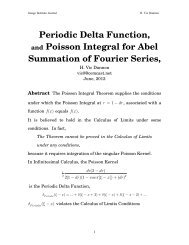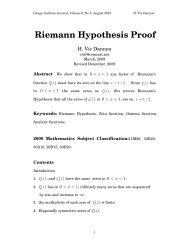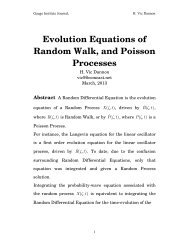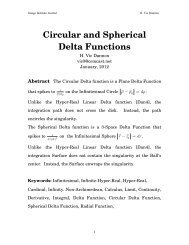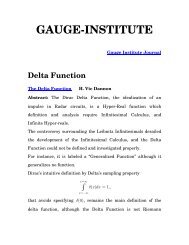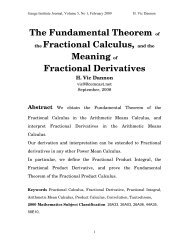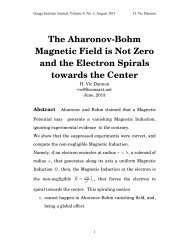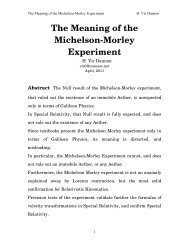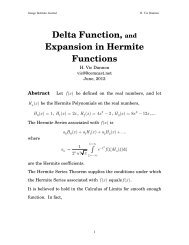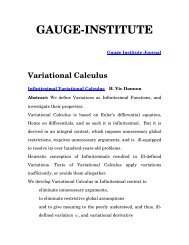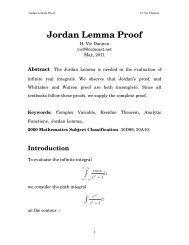Poincare Conjecture Proof - Gauge-institute.org
Poincare Conjecture Proof - Gauge-institute.org
Poincare Conjecture Proof - Gauge-institute.org
Create successful ePaper yourself
Turn your PDF publications into a flip-book with our unique Google optimized e-Paper software.
<strong>Poincare</strong> <strong>Conjecture</strong> <strong>Proof</strong>H. Vic DannonA manifold is Simply-Connected iffany loop in it is contractible to a point.For instance, on the 2-dimensional sphere, any loop is contractibleto a point.On the other hand, the 2-dimensional Torus surface has loops thatcan not be contracted to a point.A non-self-intersecting curve homeomorphic to a loop, may not bedeformed into a loop, and we do not consider it a loop.For instance, a non-self-intersecting figure-eight is homeomorphicto a loop, but in the confinement of two dimensions, it cannot bedeformed into a loop.Three dimensions are required to twist, unknot, and deform thefigure-eight into a loop.Similarly, the following knotis homeomorphic to a loop, but cannot be deformed into a loop in4
<strong>Poincare</strong> <strong>Conjecture</strong> <strong>Proof</strong>H. Vic Dannonthe confinement of two dimensions.Four dimensions are required to twist, unknot, and deform it intoa loop [6], [2].3. Border of the <strong>Poincare</strong> ManifoldA 2-manifold is borderless iff it is‣ Connected, and‣ Its finite triangulation is such that each side of a triangle inthe triangulation is glued to one and only one side of anothertriangle [1].This guarantees no border points with neighborhoodshomeomorphic to semi-disks, as it happens with points on theequator of a half-hemisphere.The half-hemisphere has a non-closed triangulation, and theequator is its border.5
<strong>Poincare</strong> <strong>Conjecture</strong> <strong>Proof</strong>H. Vic DannonIn contrast, the 2-dimensional sphere has a closed triangulation,and is borderless.Edwin Moise established in [5] that any 3-dimensional manifoldhas a finite triangulation.Thus, a 3-manifold is borderless iff it is‣ Connected, and‣ Its finite triangulation is such that each face of atetrahedron in the triangulation is glued to one and only oneface of another tetrahedron.4. Pencil Bundle Structure on the <strong>Poincare</strong> ManifoldWe construct the <strong>Poincare</strong> Homeomorphism between the <strong>Poincare</strong>Manifold and the 3-sphere, as the union of homeomorphisms fromdisjoint 2-maniflds that partition the <strong>Poincare</strong> Manifold, ontorespective disjoint 2-spheres that partition the 3-sphere.We will show that each of the disjoint 2-manifolds is Compact,Simply-Connected, and Borderless.Then, by the theorem for 2-manifolds, each 2-manifold ishomeomorphic to its corresponding 2-sphere.The <strong>Poincare</strong> Homeomorphism will be the union of thesehomeomorphisms.6
<strong>Poincare</strong> <strong>Conjecture</strong> <strong>Proof</strong>H. Vic Dannon4.1 Circle Bundle, and Pencil BundleThe 2-dimensional sphere{( 1, 2, 3): 1 2 31}2 2 2 2S = x x x x + x + x =is a circle bundle [10], a fiber bundle whose fibers are circles, overthe 1-dimensional sphere{( 1, 2): 1 21}1 2 2S = x x x + x = .Each circle in the bundle is parametrized by the angle φ ∈ [0,2 π].As φ varies, the circle follows through a pencil [10] of 1-dimensional spheres1S .The figure depicts a pencil of 2-dimensional φ -angle planes.Each is a Euclidean space 2 E that contains a 1-dimensional1sphere S , and the x3axis.The pencil is generated by turning the 1-spherex3that lies on the sphere’s diameter in the 3 rd1S about the axisdimension.7
<strong>Poincare</strong> <strong>Conjecture</strong> <strong>Proof</strong>H. Vic Dannon4.23 3 4The Pencil Bundle Structure of S is induced on Σ and on E<strong>Proof</strong>: As a compact set in a metric space, the <strong>Poincare</strong> Manifoldis bounded by a 3-dimensional sphere of radius a .We’ll assume that a = 1, and that the sphere is centered at theorigin of the 4-dimensional space that contains it. That is, thesphere is3S . The four coordinate axes are x1, x2, x3, and x4.The 3-dimensional sphere 3 S is a circle bundle [10], over the 2-2dimensional sphere S .Each circle is parametrized by the angle θ ∈ [0,2 π].As θ varies, the circle follows through a pencil [10] of 2-dimensional spheres2S .The figure depicts a pencil of 3-dimensional θ -angle hyperplanes.Each is a Euclidean space 3 E that contains a 2-dimensionalsphere2S , and the x4axis.8
<strong>Poincare</strong> <strong>Conjecture</strong> <strong>Proof</strong>H. Vic DannonThe pencil is generated by turning the 2-spherex4that lies on the sphere’s diameter in the 4 th2 3θ2S about the axisdimension. Denote( θ- - )S = S ∩ the angle hyperplane that contains the x axis .Then, { S 2 θ: θ [0,2 π]}∈ is a partition of3S since4S3 2∩ =∅ for θ1 ≠ θ2, and S = ∪ S θ.2 2Sθ θ1 2θ∈[0,2 π]2Each S θcorresponds to2 3θ( the θ- angle hyperplane that contains the x -axis)Σ ≡ Σ ∩ ,and { 2 θ: θ [0,2 π]}Σ ∈ is a partition of3Σ since4θ∩ θfor θ1 ≠ θ2Σ Σ = ∅1 2, andΣ = ∪ Σ .3 2θθ∈[0,2 π]2Each Σθis embedded in the 3-dimensional Euclidean space3 4θ( θ- - )E ≡ E ∩ the angle hyperplane that contains the x axis ,and { E 3 θ: θ [0,2 π]}∈ is a partition of4E since4E4 3∩ =∅ for θ1 ≠ θ2, and E = ∪ E θ.3 3Eθ θ1 2θ∈[0,2 π]4.3Tθ≡T∩2( the θ- angle hyperplane ) is a topology on Σθ≡ G ∩ ( the θ angle hyperplane )with open sets G -θ<strong>Proof</strong>:2T is the relative topology of T on Σ .θθ9
<strong>Poincare</strong> <strong>Conjecture</strong> <strong>Proof</strong>H. Vic Dannon24.4 Each Σθis Hausdorff<strong>Proof</strong>: Every subspace of Hausdorff is Hausdorff. 24.5 Each Σ is a 2-manifold with the topology Tθ2<strong>Proof</strong>: Each point x ∈Σ , has a 2-dimensional open neighborhood2 3x x-( θ)θU = U ∩ the angle hyperplane , homeomorphic to a 2-dimensional disk D 2 B 3( the θ-angle hyperplane )x= ∩ .xθ4.6EachΣ2θis Compact2<strong>Proof</strong>: Σθis compact, as a subset of the compact3Σ .24.7 Each Σθis Connected2<strong>Proof</strong>: If Σθis disconnected, then3Σ is disconnected.24.8 Each Σθhas a Closed Finite Triangulation2<strong>Proof</strong>: Σθinherits a finite triangulation from3Σ .2Each side of a triangle in the induced triangulation on Σθ, is onthe face of some tetrahedron from the triangulation of3Σ .10
<strong>Poincare</strong> <strong>Conjecture</strong> <strong>Proof</strong>H. Vic DannonThe tetrahedron shares its face with one and only one othertetrahedron.Consequently, the triangle side is glued to one and only one side of2another triangle, and the triangulation of Σθis closed.24.9 Each Σθis Borderless<strong>Proof</strong>: By 4.7 and 4.8, eachΣ 2 θis connected, and has a closed2finite triangulation. Therefore, Σθhas no boundary.24.10 Each Σθis Simply-Connected<strong>Proof</strong>:If2θΣ is not simply-connected, there is a loop02θ in0Σ2θ0that is prevented from contracting by a 2-disk2θbelong toΣ .02D θ0that does notBut2θΣ has no boundary, and it cannot contain the disk0boundary.Therefore, the loop2θ must be slipping along the surface of a 2-02Torus T θ.011
<strong>Poincare</strong> <strong>Conjecture</strong> <strong>Proof</strong>H. Vic DannonThe Torus surface has no boundary and can be part ofΣ2θ0, but theinterior of the Torus does not belong to2θΣ .0The interior lies in the 3-dimensional Euclidean space3E θ0thatcontains2θΣ .0Since the E 3θare disjoint from each other, the non-contractingloop2θ0, and the Torus2T θ0are embedded only in3E θ, and in none03of the other E θ.Therefore,2θ3 , does not contract in any other E θ, and in none of02the Σθ. Hence,2θ does not contract in02 3∪ ( Σθ, θ)= Σ .θ∈[0,2 π]Consequently, the <strong>Poincare</strong> Manifold has a loop that is notcontractible, and3Σ is not Simply-Connected.This says that if Σ 3 is Simply-Connected, eachΣ 2 θis simplyconnected.12
<strong>Poincare</strong> <strong>Conjecture</strong> <strong>Proof</strong>H. Vic Dannon2 2 2 24.11 Each Σθ is homeomorphic to Sθ with fθ : Σθ → Sθ<strong>Proof</strong>: By 4.5, 4.6, 4.9, and 4.10, eachΣ 2 θis a 2-dimensionalmanifold, which is Compact, Borderless, and Simply-Connected.By the theorem for 2-dimensional manifolds [4], such manifold ishomeomorphic to the 2-dimensional sphere.5. Constructing the <strong>Poincare</strong> HomeomorphismWe proceed to construct the <strong>Poincare</strong> Homeomorphism as theunion of the homeomorphisms f θ.To that end, we will apply a theorem from [9].5.1 S is a subbase for a topology T on X∙ S is a subbase for a topology T on X¸f : X → Xis¬ one-one function which induces aÁ one-one correspondence between the elements ofS , and the elements of SThen, f is a homeomorphism between X , and XLet τ be a topology on1S , with open sets Θ .We proceed to write T in terms of Tθ.13
<strong>Poincare</strong> <strong>Conjecture</strong> <strong>Proof</strong>H. Vic Dannon5.2∪T = T has open sets G =∪θθ∈[0,2 π]θ∈ΘGθ<strong>Proof</strong>:(⊇ ) For each θ ∈ [0,2 π], T ⊇ Tθ.(⊆) If x ∈G∈ T , then x belongs to some θ -angle hyperplane forsome θ [0,2 π]by 4.3. ∩∈ . Hence, ( θ-)x ∈ G the angle hyperplane = G θ∈ T θ25.3 For each θ , f θT θis a topology on S θ, with open sets f θG<strong>Proof</strong>: For each θ ∈ [0,2 π], f θis homeomorphism.θ5.4= ∪3fθ θis a topology on S with open sets ∪ fGθ θθ∈[0,2 π]θ∈Θ∈τT T .<strong>Proof</strong>:Empty set∅∈Tθ⇒ ∅∈f θ θT ⇒ ∅∈ f∪ θT θ= T .θ∈[0,2 π]2The Space Σθ∈ T ⇒θ∪ ∪ T T .3 2(θ, θ)θ θθ∈[0,2 π] θ∈[0,2 π]S = S ∈ f =Infinite UnionFor any i∈ I , letiG∈T. We’ll show thatiG∈∪ T .i∈IFor each ii∈ I , there is Θ ∈ τ , so that for all θ i ∈Θ, i there areG iθiii∪ . Hence,Gf G∈ T i so that =iθθ iθi iθ ∈Θ14
<strong>Poincare</strong> <strong>Conjecture</strong> <strong>Proof</strong>H. Vic DannoniiG∪ = ∪ ∪ f θiGi.θi ii∈I i∈Iθ ∈ΘTaking the union first over all iSinceiG∪ = ∪ ∪∈ θ∈Θ ∈i I i i Ii∈ I , then over all θ ∈∪ Θ ,∪i∈Iii∪ Θ ∈ τ , and ∪ fθGθ ∈ fθ θi∈Ii∈IFinite intersectionLetSince 1 21 2T . We’ll show that G , G∈ 1 2T , there areG , G∈ fG θiθT , we haveG ∩G ∈ T .i∈IiG∈∪ T .i∈I1 21 1Θ , Θ ∈ τ so that for all θ ∈Θ , and2 2for all θ ∈Θ , there are ∈ T 1 , ∈ T 2 so thatG 1θ1θG 2θ1 12 2= ∪ f θ1G1, and G = f 2 2θθGθ1 12 2Gθ ∈Θ2θ∪ .θ ∈ΘHence,∩ ∪ ∩ ∪GG= f G f G1 2 1 21 1 2θ2θθ θ1 1 2 2θ ∈Θ=θ∈Θθ∈Θ∪ f G ∩1 2∩Θ1 2θ θfGθ θ1 2 1 2Since Θ∩ Θ ∈ τ , and fθGθ∩fGθ θ∈ fθT θ, we have1 2GG∈∩ T .5.5 is Σ3 { θθ ∈ π }T Sup Topology on , and T : [0,2 ] partitions T15
<strong>Poincare</strong> <strong>Conjecture</strong> <strong>Proof</strong>H. Vic Dannon<strong>Proof</strong>: T is the smallest topology onTθ. Such topology is called sup topology [11].3Σ which is larger than eachIn [11], each of the topologies is defined on the same space X , and2 3contains it. Here, for each θ , Tθ⊆Σθ ⊆Eθ, and all the Tθaredisjoint from each other. { : ∈ [0,2 ]}∩T θ T θ=∅ for 1 21 2θ≠θTθθ π partitions T since, andT = ∪ Tθ.θ∈[0,2 π]5.63T is Sup Topology on S , and f : [0,2 ] partitionsθT θθ ∈ πT{ }<strong>Proof</strong>:fθ Tθ∩fθ Tθ=∅for θ 1≠ θ 2, and T = ∪ θ]f T θ.[0,21 1 2 2θ∈π25.7 For each θ , let Sθbe a Subbase for Tθon Σθ, with sets H θ.Then,∪S is a subbase for T , with subbase setsθθ∈[0,2 π]θ∈Θ∈τ<strong>Proof</strong>: If G ∈ T , there is∪Θ∈ τ , and there are G θ∈ T θ, so thatGFor each G θ, there are base sets= ∪ G θ.θ∈ΘjB θ, j∈ J , so thatHθGθ= ∪ Bj∈JjθFor eachjjk ,B θ, there are subbase sets H θ∈ S , k = 1... n so thatθ16
<strong>Poincare</strong> <strong>Conjecture</strong> <strong>Proof</strong>H. Vic DannonTherefore,GBjθnjk ,H θθ∈Θ j∈ J k=1= ∪∪∩njk ,H θj∈ J k= 1 θ∈Θ= ∪∩∪ .n= ∩ Hk = 1j,kθThus,∪ Sθis a subbase for T , with subbase setsθ∈[0,2 π]∪ .H θθ∈Θ∈τ5.8 For each θ , f θS θis a subbase for f θT θwith subbase sets f θH<strong>Proof</strong>: For each θ ∈ [0,2 π], f θis homeomorphism.θ5.9 3∪ fθSθ is a subbase for T o n S with subbase sets ∪ fθHθθ∈[0,2 π]θ∈Θ∈τ<strong>Proof</strong>: If G ∈ T , there is Θ∈ τ , and there are f G ∈ fFor each G θ, there are base setsG = ∪ fG .θ∈ΘθθjB θ, jjθ θfθBθj∈Jf G= ∪∈ J , so thatθ θ θ θT , so thatFor eachjjk ,B θ, there are subbase sets H θ∈ S , k = 1... n so thatθ17
<strong>Poincare</strong> <strong>Conjecture</strong> <strong>Proof</strong>H. Vic DannonTherefore,njj,kθ θ= ∩ fθHθk = 1f BnG = ∪∪∩θ∈Θ j∈ J k=1f H θjk ,θThus,nj∈ J k= 1 θ∈Θjk ,θ= ∪∩∪ f H .θ∪ f θS θis a subbase for T , with subbase sets f θH θθ∈[0,2 π]θ∈Θ∈τ∪ .To obtain the <strong>Poincare</strong> Homeomorphism by 5.1, we need to definea functionf3 3: Σ → S which is¬ one-oneÁ one-one correspondence between a subbase set for T ,∪ , and a subbase set for T , ∪ f θH θ.H θθ∈Ωθ∈Ω5.10 Definition of f32For x ∈Σ , there are unique θ ∈ [0,2 π], and ∈Σ so thatx θθx= ( x θ, θ).We define the mapping f from3Σ onto3S by fx ( , θ) = ( fx, θ).θ θ θ18
<strong>Poincare</strong> <strong>Conjecture</strong> <strong>Proof</strong>H. Vic Dannon5.11 f is one-one<strong>Proof</strong>:LetAssume that2Since Σθare disjoint,θSince f θis a homeomorphism,Hence,x = ( x θ, θ), and y = ( y φ, φ).( f x , θ) = ( f y , φ).θ θ φ φ= φ, and f x = f y .xxθ= y .θ θ θ θθ= y.5.12f is one-one between the subbase set H in Sand the subbase set∪θ∈ΘfHθθinΣ3∪θ∈Θθ3<strong>Proof</strong>: Let H = ∪ H θ, and K = ∪ K φ.θ∈Θφ∈ΦAssume that,{( f H , θ): θ , H H} {( f K , φ): φ , K K}∈Θ ⊆ = ∈Φ ⊆ .θ θ θ φ φ φ2Since the Σθare disjoint,Θ=Φ, and fθHθ = fθKθ, for any θ ∈Θ.Since f θis a homeomorphism, for each θ ∈Θ,Hence, H= K.Hθ= K .θ19
<strong>Poincare</strong> <strong>Conjecture</strong> <strong>Proof</strong>H. Vic Dannon5.13 f is the <strong>Poincare</strong> Homeomorphism<strong>Proof</strong>: By 5.1, 5.2, 5.4, 5.7, 5.9, 5.11, and 5.12, f is a homeo-33morphism. It is the <strong>Poincare</strong> Homeomorphism from Σ onto S .25.14 The <strong>Poincare</strong> Homeomorphism restriction to Σθis f θ.f= fΣ θ.2θ5.15 The <strong>Poincare</strong> Homeomorphism is the union of all the f θ.{ : θ [0,2 π]}f = f ∈ = ∪ f .θθθ∈[0,2 π]20
<strong>Poincare</strong> <strong>Conjecture</strong> <strong>Proof</strong>H. Vic DannonReferences[1] Borisovich; Bliznyakov; Izrailevich; Fomenko; Introduction to Topology.MIR publications, 1985.[2] Firby & Gardinger, Surface Topology, Ellis Horwood, 1982, p.20.[3] Gaal, Steven, Point Set Topology, Academic press, 1964.[4] Massey, William, Algebraic Topology: An Introduction Harcourt, Brace,and World, 1967.[5] Moise, Edwin, “Affine structures in 3-manifolds, V: The triangulationtheorem and Hauptvermutung.” Ann. Math., 56, 1952, pp. 96-114.[6] Pedeo, Dan, The Gentle Art of Mathematics. Dover, 1973, p.79.[7] <strong>Poincare</strong>, H. Cinquieme complement a l’analsis situs, Rend. Circ. Mat.Palermo 18 (1904), pp. 45-110.[8] Spivak, Michael, Comprehensive Introduction to Differential Geometry,Publish or Perish, 1999. Volume 1, p.459.[9] Thron, Wolfgang, Topological Structures, Holt, Reinhart, Winston, 1966p.41, #7.5[10] Weisstein, Eric, CRC Concise Encyclopedia of Mathematics, SecondEdition, 2003, Chapman& Hall/CRC.[11] Wilansky, Albert, Topology for Analysis, Krieger, 1983, p.89.21



